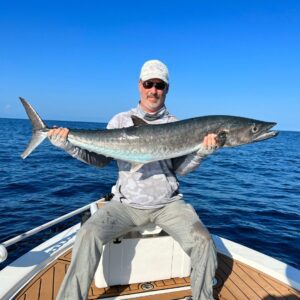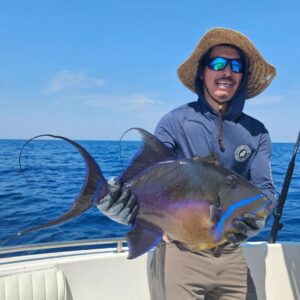North Myrtle Beach / Little River – October 2023
Buddy, of Captain Smiley Fishing Charters, reports that even with all the dirty water around, anglers are still having plenty of success flounder fishing in North and South Carolina. Both live finger mullet and Gulp baits are working, with the rising tides seeing the better action. When the waters have been low, or the tide is falling out, black drum fishing has been really good. The key to this bite has been using live or fresh dead shrimp fished in creek mouths and deeper holes with nearby structure.
Some speckled trout are around, though the bite hasn’t kicked off just yet. These last few fronts have helped cool the water some, but anglers still look forward into October for better clarity and cooler nights to really see the trout fishing fire off. A good mix of smaller (15”) and upper/over-slot (23-28”) red drum are being found just about everywhere right now. Natural baits such as finger mullet, shrimp, cut mullet, or mud minnows have been the top producing options.
Nearshore anglers are finding Spanish mackerel feeding on all this bait pushing out on the beach. The smaller Spanish are starting to move on, with the larger (to 4+ lbs.) Spanish now filling in. The bigger fish tend to feed better on free-lined live bait, where casting plugs can also work when finding a surface-feeding frenzy. Bluefish are mixed in the nearshore action. Anglers look forward to bull drum migrating into the area this fall. For now, the numbers aren’t quite enough to target them.
Chris, of Fine Catch Fishing Charters, reports that flounder action has been the main focus in the area. It’s been a nice class of 19-22” fish, the same sizes that most have found as accidental catches all year long. Fishing a Carolina-rigged finger mullet along an inshore drop-off or near oyster structure provides a good chance of success. Creek mouths can be another area to find a flounder bite. Red drum fishing has been good. The ICW docks and oyster beds have been the top areas to target. Some big red drum (35”+) are being caught around the jetties. For this bite, anglers will do best with larger mullet or menhaden, either live or dead, fished around the tide changes. Sheepshead are being caught around the jetty rocks and back around some inshore docks.
There hasn’t been a ton of opportunities to run off the beach with the run of storms we’ve had passing by. As conditions settle moving forward, there will be some good opportunities to target grouper nearshore as they stage up over some of the shallower structure in the 50-70’ range. Fishing live bait will be best tactic for keeping the smaller variety of species on these same reefs off your line, but there will likely be no shortage of American red snapper, as they’ve literally been stacked up everywhere. Keep an eye out while fishing these reefs for cobia that could pop up around the boat at any time.
Bob, of Strange Magic Fishing Charters, reports that flounder have been the main focus, with quality fish being found in deeper holes back in creeks on lower tides and off ICW grass lines on higher tides. With the flatfish, remember that structure is key. A ton of bait is around, but some of the best successes are with Z-Man or Gulp baits on jig heads. It’s the different look that triggers a reaction bite. Anglers look forward to bull red drum showing up around the Little River jetties. The standard techniques during this annual run are using bottom-rigged live mullet and menhaden or large artificials on 2 oz. jig heads. Be sure to use your bottom machine to locate the bait and structure before setting up efforts.
Bevan, of Chilly Water Fishing, reports that from now through the end of the year will see some of the best offshore bottom fishing action. The bigger black sea bass will be showing up in the 65-85’ range, and the numbers and sizes only get better as waters cool. Grouper fishing has remained strong, with gags out in the 80-100’ area and tasty scamps out a little deeper (110-140’). Anglers fishing cut squid can also find some triggerfish over structure in the 100-120’ range. Vermilion snapper will be mixed in the action at the same structures in any of these depths. With any of the bottom fish species, the deeper areas will typically have the bigger fish as they see less pressure. When offshore, be sure to keep out a drift line for the opportunity to land a king mackerel, amberjack, barracuda, or one of the scattered mahi.
Larry, of Voyager Fishing Charters, reports that there will be fish moving in shallower with the water cooling, but many anglers will find the larger fish out deep where fishing pressure is much less. Bottom fishing anglers in general will be catching any mix of large grouper, triggerfish, vermilion snapper, grunts, and black sea bass. Drift lines on these trips will entice strikes from kings and the occasional cobia. Trolling trips are targeting wahoo and blackfin tuna.
Chase, of Apache Pier, reports that bottom fishing action has been good, as anglers have found mixed bags of croakers, whiting, spot, and some pompano. Some keeper flounder have been pulled in as well. Spanish mackerel are being caught by anglers throwing plugs, especially on days with cleaner water conditions. Scattered black drum are now showing up in the surf zone.







